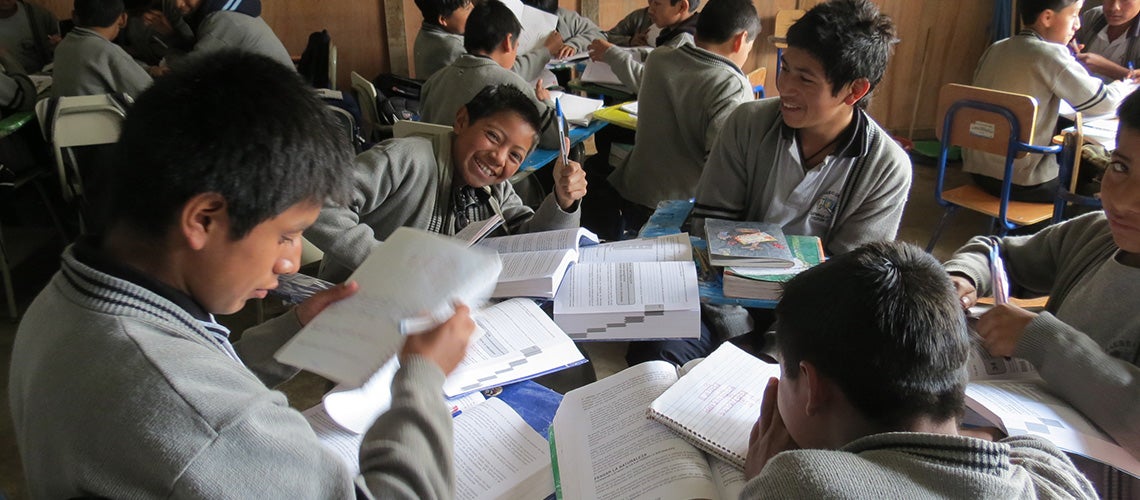 A group of kids in a school in Guatemala. Source: World Bank
A group of kids in a school in Guatemala. Source: World Bank
With more than 50 percent of its population living in hardship, Guatemala has one of the highest poverty rates in Latin America and the Caribbean. This is undoubtedly a difficult situation for us to accept, but from a historical perspective, we can nevertheless see that some progress has been made . For example, in the mid-1980s, around 83 percent of the population lived in poverty but, since then, poverty has been reduced by around 30 percentage points.
The situation in Guatemala has also improved in other ways in recent decades: primary school enrolment for example has increased, as have investments in social protection. It has also been possible to bring down the mother and infant mortality rate and increase the number of females doing remunerated work in the labor market.
Regardless of current difficulties, Guatemala has certainly made progress and has great potential thanks to its many strengths . Its economy, the largest in Central America, has benefited from prudent macroeconomic management which over the last decade has contributed to delivering an average of 3.5 percent real economic growth per year. With over half of its multiethnic population under 29 years old, and considering its great biodiversity, the country possesses enormous cultural and natural wealth. In addition, its geographical position offers many opportunities for tourism and nearshoring.
To achieve the progress made in recent years, Guatemala has invested substantial effort and, like many other countries, has been able to rely upon the support and follow-up of regional partners and cooperation agencies, including the World Bank.
World Bank support for Guatemala — through financial and technical assistance in more than a dozen areas — has rendered positive economic and social results , of which the following are a few examples:
- Through the Competitiveness Project (Proyecto de Competitividad), the Invest in Guatemala agency facilitated new direct foreign investments of US$ 944 million between 2005 and 2008, which led to the creation of 24,000 new jobs.
- The Project to Support a Rural Economic Development Program (Proyecto de apoyo al Programa de Desarrollo Económico desde lo Rural) improved the competitiveness of production chains and supported the creation of 200 new associations of small rural producers, which led to an increase of their total sales by US$ 20.3 million.
- The Maternal and Child Health and Nutrition Project (Proyecto de Salud y Nutrición Materno-Infantil) expanded the coverage of health and nutrition to more than a million people, reduced the maternal mortality rate between 2006 and 2012 by more than a half in the intervention zones, and increased the percentage of prenatal care for pregnant women from 54 percent to 89 percent in the same period.
Video: Addressing priorities for Guatemala's development
The way to go
Despite these advances a number of challenges remain. Large sectors of the population — mainly in rural and indigenous areas—have no access to health, nutrition, education, electricity, economic opportunities and formal employment
We need to boost the productivity of companies and workers, increase investment in infrastructure, human capital and innovation, and work towards getting more people, especially women, into the formal labor market .
Is Guatemala able to face up to these challenges? Of course it is . Of this there can be no doubt.
As part of its commitment to the country and recognition of its potential, the Executive Directorate of the World Bank has endorsed the new Country Partnership Framework, which will guide our technical and financial assistance between 2024 and 2027. This support, which could reach as much as US$2.5 billion in terms of funding, will focus on strengthening human capital, increasing resilience to disasters, emergencies and climate change, and improving job opportunities. It will also help to strengthen institutional capacity and promote inclusion.
Guatemala has enormous potential to generate growth and prosperity for its entire population. Treading this path towards a promising future will require a clear strategy , collective commitment and political will to implement a solid social agenda and adapt to the climate challenges with the ultimate objective of achieving investment grade status.
Let's join forces to build a Guatemala with a promising future! With the new Country Partnership Framework the World Bank reaffirms its continuing commitment to foster more development opportunities and better living conditions for more families.
If you want to receive one article a week,
Related articles


Join the Conversation